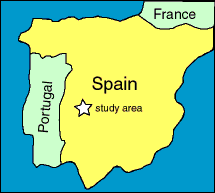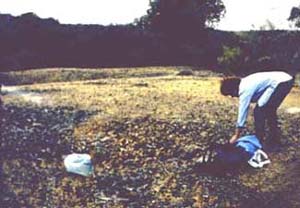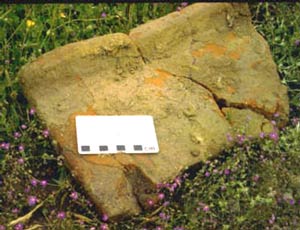
|
|
|
|
|
|
|
|
|
|
|
|
|
|
|
|
|
|
|
|
|
|
|
|
|
|
|
|
|
|
|
|
|
|||||||
|
|
|
|
|
|
|
|
|
|
|
|||||||||
|
|
|
|||||||||||||||||
|
|
|
|||||||||||||||||

Robert G. Schmidt, Scientist Emeritus, U.S. Geological Survey, Reston, Virginia, and Research Associate, National Museum of Natural History, Smithsonian Institution, Washington, D.C., USA
Cathy M. Ager, Geobotanist, U.S. Geological Survey, Denver, Colorado, USA, and
Juan Gil Montes, Geologist, Instituto Bachillerato el Brocense, Cáceres, Spain
Adapted from a poster presented at Metals in Antiquity Symposium, Harvard, September 10-13, 1997 (Schmidt and others, 1999). Revised, February, 2001.
While industrial contamination of the environment in the Americas is mostly limited to post-European settlements, a significant metallurgical industry yielding voluminous toxic waste was well established in the Old World by 2500-2000 years ago (Nriagu,1998). Attention has been drawn to the magnitude of this industry by the substantial increase in worldwide atmospheric lead attributed to Greek and Roman smelting of lead-silver ores from about 2,500 years before the present, and recorded in Greenland glacial ice cores (Hong and others,1994), in Swiss and Spanish peat bogs (Shotyk and others, 1998), and in Swedish lakes. Pyatt and others (2000) have also studied the persistence of toxic metals in an area of ancient mining and smelting and the potential influence on the environment.

The Plasenzuela silver-lead district in Cáceres Province, Extremadura, in west-central Spain was exploited by Roman miners for roughly 100 years starting about 30-20 B.C., and by modern miners from the 1850's to 1908 (Domergue, 1987). We see evidence of extensive smelting in the district only during the Roman period. Significant amounts of the toxic metals lead, zinc, arsenic, cadmium, and copper persist in mine waste-rock dumps of probable Roman origin, and in dumps of smelter slags certain to be Roman. Metals from both Roman-age and modern mining industry have been dispersed widely in the surrounding environment,and especially in associated soils and plants and river alluvium. An extensive area where soil lead concentrations exceed the normal regional background of 40 ppm at many sites remains unexplained, but some of it may be the result of air-borne deposition of fumes from the Roman smelting furnaces.
The Plasenzuela Project studies the retention and dispersion of metals into the environment from all sources, but especially from the two millenia old Roman industry, providing a time span not available in the Western Hemisphere. The relatively simple history of the district and the lack of subsequent disturbance of part of the ancient wastes make this area an ideal site for such a study. The project is multidisciplinary, involving geologic, geochemical, geobotanical, and archaeo-metallurgical methods, and compliments current studies of much younger mine waste problems by the U.S. Geological Survey and its Spanish counterpart, the Instituto Tecnológico GeoMinero de España.
The ores were originally deposited as sulfides in narrow, nearly vertical veins, formed in a sequence of tightly folded slates and graywackes. The gangue, or non-useful, minerals in the veins was mostly quartz and carbonates. The upper parts of the veins, perhaps the upper 60 meters, would have been oxidized by surface waters. Important changes in the smelting process may have been required when the Roman mines reached below the oxidized ore zone and extracted the sulfide ores at greater depth.

The Roman-age miners extended their underground workings to a depth of at least 137 m, or perhaps 80 meters below the water table. Shallow pits and trenches were surely common as well, but are now mostly obscured or not recognized. The ancient mines operated from about 20 B.C. to about 80 A.D., or during the reigns of the emperors Augustus through Vespasian. The Roman-age workings were best observed when the modern mines were operating and a few Roman artifacts were recovered from depth. Safe examination of the Roman mine workings would yield invaluable information, but is beyond the resources of the present project.
At the outset of the Plasenzuela Project, we expected to find significant amounts of metals in the mine waste-rock dumps and in the smelter slags, not realizing that measurable contamination is also present in vegetation, in downslope sediments leading into the river, in alluvium of the Río Tamuja downstream for at least 18 km below the last mine, and probably in aqueous mine drainage. Soils on a ridge crest north of the smelters, in a partly delineated area at least 200 meters long, contain as much as 1200 ppm lead and elevated zinc and arsenic. Some of this may be related to substrate mineralization, and we are awaiting analytical results from a broader sample net and from many samples taken in test holes augered to 40-80 cm depth. Previous analyses show that metal levels increase in depth at some sites, but decrease at others. Possibly some of the metals are derived from fallout from the ancient smelter gases.

Differentiation between ancient rock dumps and small well-weathered modern dumps is difficult. All suspect Roman mine-waste is now mostly earthy, with fewer and smaller fragments of slaty rock than dumps that are clearly modern. Some slate fragments have percussion marks that we believe indicate that they were extracted by using a small pick. At one site, several heavily patinated metallic lead fragments were found 10-20 cm beneath the surface. Limited archaeological excavations to more-surely verify the ages of waste-rock dumps are included in our future project plans.
|
Soil sample collection points. Soil from the middle site contains 1.3% lead. but the vegetation here shows no obvious effects of the toxic metal and the oaks have taken up little of the lead. (See also Anderson and others, 2000, regarding lead uptake by oak trees near smelter sites.) |

Piles of weathered waste rock from suspected Roman mine. |
There is as much as 20,000 ppm (2.0%) lead, 7000 ppm (0.7%) zinc, and 5000 ppm (0.5%) arsenic in the dump soils, much higher than soils over similar rock outside the mining area where maxima rarely exceed 40 ppm lead, 115 ppm zinc, and 100 ppm arsenic. Soil sample transects on the dump surfaces and extending downslope below them indicate that metals continue to be transported into the local drainage systems. While the total affected areas are relatively small, they are more than sufficient to demonstrate the potential persistence of toxic metals in favorable soils. They make up only small portions of large pasture areas and generally provide but scant forage. Estimation of potential human impact is premature.
Smelting was carried out in an area 700 m long close to the RíoTamuja, now marked by several thousand tons of smelter waste. We have not found the furnaces themselves, but there are scattered pieces of granite furnace wall coated with slag, and places on the bedrock surface where we think that furnace bases rested.

|
Edge view of Roman roof tile fragment showing how the edge is thickened. 
|
Roof tile fragments with typical raised and thickened edges. Surface of the smelter slag dump. Three pieces of weathered and rounded Roman roof tile rest on the surface. Unworn, sharp-edged tile fragments buried within the slag are our best confirmation of the Roman age of the slag dump. |
The slag, a waste product of smelting incorporating most of the unwanted elements in the ores, here consists of platy pieces 1-3 cm thick with wrinkled or bubble-pocked upper surfaces,the largest pieces up to 25 cm long, and thicker irregular chunks.

It was tapped or allowed to flow from the furnaces and solidify outside in round shallow molds. Most of the slag is dense and dark gray to black and appears stony or visibly crystalline; sparse fragments are glassy, and some consist of translucent glass enclosing minute bundles of acicular crystals near fayalite in composition. Large vesicles, one-half to two-cm thick and several cm in horizontal dimension, are common, and some of the thicker chunks appear to be built up of multiple taps into the same basin with several parallel horizontal vesicles. We are puzzled that in examination of great numbers of slag pieces, we have recognized no spaces in the slag where the molten metal seemed to have formed.
Uneroded Roman roof tile fragments are found deep within the slag piles. Roswag (1853), who had access to the ancient mines before modern mine development began, regarded the slag as Roman in origin. There is no evidence for significant smelting in the district since Roman times.


| The question of glassy coatings on certain roof tiles near the furnaces -- Toward the end of our latest field season we noted that many pieces of Roman-design roof tile in the area of the slags were coated with a layer of very hard, crusty material. Generally dull gray on the surface, the broken edge of the crust appears vitreous and dark gray to black. In one piece that we had analysed, the coating proved to be more than 40 percent lead. Ten other samples were tested with a simple field test for lead and all were strongly positive. The lower surface of each tile, that opposite to the raised rim (see figure below), has more of the coating and has formed drips which indicate that the orientations of the tile fragments were always the same, and in a high-temperature environment, but not as hot as the zone where smelting took place. They are so common that their placement must have been intentional and purposeful. In a book called "King Croesus' Gold," (Ramage and others, 2000, p. 161), lead oxide-coated ceramic fragments shaped much like Roman roof tiles were called "bread trays". These were consistently coated with lead oxide on the side of the raised rim. The authors believe them to have played a role in the cupellation process. We wonder if deliberate placement of the tiles as shelf-like projections in a cupellation hearth or furnace structure had been an attempt to recover some of the gaseous losses since there was surely considerable loss of lead and silver during both smelting and cupellation. It is intriguing to speculate that Roman and even earlier metallurgists might have recognized this manner of metal loss and sought to reduce it. |

| Separation of silver from the lead-silver alloy -- Two molten fluids were tapped from the furnace and allowed to solidify in a small basin shaped in the ground or in finely-broken slag: a lead-silver metal alloy which was the most dense and would have settled on the bottom, to be overlain by the slag, a semi-glassy largely silicate material. The silver metal was then separated from the lead by cupellation, a process already ancient in Roman time. The metal was placed in a shallow open basin or ceramic bowl (the cupel) in a furnace and a strong blast of air blown across the surface of the molten metal. The lead oxidized to form PbO (litharge, from Greek for the "spume of silver"), the relatively pure silver remained as metal. The litharge could then be recycled through the smelting furnace to recover the lead metal. For more extensive discussions of ancient silver smelting and cupellation, see Craddock (1995). We have found no litharge near the smelters in our area, and no ceramic vessels that might resemble cupels, nor other evidence that cupellation was carried out at this site. However, field evidence of cupellation has been mentioned by Roswag (1853) and Domergue (1987). We have found a plate of litharge on a mine dump a kilometer distant. |
Most slag samples contain 5-7% lead, 3-7% zinc, and 0.02-0.04% arsenic. Ores here are arsenic-rich, but much arsenic would have been vaporized in the smelting process, hence there is relatively little in the furnace products. As with the waste-rock dumps, soil and dissolved metals are transported downslope and eventually into the Río Tamuja. Located close to the Río Tamuja, slag continues to be swept from the piles in major floods and is present in river gravels as far as 23 km downstream. However, many thousands of tons of slag remain.
Soils interstitial to the slag fragments contain 1.5-2.3% lead and 0.3-0.6% zinc, thus the Pb/Zn ratio is higher in the soil. These metals may be contained in fine smelter waste in the soil, or perhaps leached from the slag fragments.
Soils at many sites that seem well removed from mining or transportation activity as well as from mineralization, nevertheless contain anomalous lead. Soil analyses at 323 sites in the southern part of the district delineate an area where the lead in many samples exceeds 40 ppm, the normal background in the region. The anomalous area crosses rock types, diverges from the trend of mineralization, and extends northeastward, the probable prevailing downwind direction.


The higher-than-normal lead concentrations lack a certain explanation, but we propose that they may be air-borne deposits from the Roman smelting furnaces, preserved in the soil blanket. If this interpretation is correct, it may further mean: (1) The amount of soil erosion that can have taken place in the Tamuja valley since the end of Roman mining is limited; and, (2) Significant soil contamination from smelter fumes may also persist in soil for many centuries. Our 1999 and 2000 field work has included many samples taken from auger holes to help determine if the anomalous soil lead is confined to a thin layer at the surface and results of many of these analyses are expected in early 2001.
Sampling and analyses of many different environments in the Plasenzuela silver-lead mining district show that significant metals persist in the ancient mining and metallurgical wastes, and have migrated into adjacent soils, contaminated river sediments, been taken up by plants, and may have been distributed by smelter plumes to more distant soils in the area. Though Plasenzuela is a relatively small mining district, even by Roman terms, its relative simplicity compared to the enormous and complex wastes of other ancient mining districts in the Iberian peninsula make it an excellent place to begin seeking an understanding of mining and metallurgical waste behavior over extended time.
Anderson, S., Chappelka, A.H., Flynn, K.M., and Odom, J.W., 2000, Lead accumulation in Quercus nigra and Q. velutina near smelting facilities in Alabama, U.S.A.: Water, Air and Soil Pollution, 2000, v. 118, n. 1-2, p. 1-11.
Conophagos, Constantine, 1982, Smelting practice at ancient Laurion: in The evolution of the first fire-using industries, Wertime, T.A., and Wertime, S.F., [eds.], Washington, D.C., Smithsonian Institution Press, p. 181-191.
Craddock, P.T., 1995, Early metal mining and production: Washington, Smithsonian Institution Press, 363 p.
Domergue, Claude, 1987, Términomunicipal: Plasenzuela, in Catalogue des mines et des fonderies antiques de la Peninsule Iberique: Publications de la Casa de Velazquez, serie archeologie, Fac. VIII, T. 1, p. 53-57.
Hong, Singmin, Candelone, J-P, Patterson, C.C., and Boutron, C.F., 1994, Greenland ice evidence of hemispheric lead pollution two millenia ago by Greek and Roman civilizations: Science, v.265, p. 1841-1843.
Jones, J.E., 1984, Ancient Athenian silver mines, dressing floors and smelting sites: Jour. Historical Metallurgy Society, v. 18, p. 65-81.
Nriagu, J.O., 1998, Tales told in lead: Science, v. 281, p. 1622-1623.
Pyatt, F.B., Gilmore, G., Grattan, J.P., Hunt, C.O., and McLaren, S., 2000, An imperial legacy? An exploration of the environmental impact of ancient metal mining and smelting in southern Jordan: Jour. Archaeological Science, v. 27, p 771-778.
Ramage, Andrew, Craddock, Paul, and Craddock, P.T., 2000, King Croesus' Gold: Harvard University Press, 264 p.
Roswag, Clemente, 1853, Apuntes sobre las minas de Palacios y Golondrinas, y refutacion del informe del señoringeniero Letellier: Cáceres, 108 p.
Schmidt, R.G., Ager, C.M., and Gil Montes, Juan, 1999, A study of Roman mining and metallurgy and their environmental consequences at Plasenzuela, Extremadura, Spain: in Metals in Antiquity, S.M.M. Young, A.M. Pollard, Paul Budd, and R.A. Ixer, eds., British Archaelogical Reports, Series 792, Oxford, Archaeopress, p. 234-242.
Shacklette, H.T., and Boerngen, J.G., 1984, Element concentrations in soils and other surficial materials of the conterminous United States: USGS Professional Paper 1270, 105 p.
Shotyk, W., Weiss, D., Appleby, P.G., Cheburkin, A.K., Frei, R., Gloor, M., Kramers, J.D., Reese, S., and Van Der Knaap, W.O., 1998, History of atmospheric lead deposition since 12,370 14C yr BP from a peatbog, Jura Mountains, Switzerland: Science, v. 281, p. 1635-1640.
Research grants from the National Geographic Society Committee for Research and Exploration and from the U.S. Department of the Interior, Human Resources Initiative, made the project possible by supporting data collecting trips, and paying part of the analytical costs. The U.S. Geological Survey provided analytical and salary support. Carmen Anton-Pacheco and Pablo Gumiel, of the Instituto Tecnológico GeoMinero de España, Madrid, helped us in the field and introduced us to the local scientists who gave us much assistance and made the work much more enjoyable. Our colleagues at the University of Extremadura, especially Jose Maria Fernandez Corrales, Enrique Cerrillo Martin, , Dionisia Gomez-Amelia, and Susanne Schnabel were most generous with their advice and time, and to them we are ever so grateful. Juan Carlos Casco and Marcelino Moreno Morales, Centro Piloto de Estudios y Proyectos, Ayuntamiento de Plasenzuela, gave us significant help in understanding the history, culture, and particularly the agricultural practices of our working area. We owe special thanks to Elena Aguilera Collado of the Museo Minero, Minas de Riotinto, Spain, for introducing us to the Roman metallurgical sites at Rio Tinto, and for sharing her interpretations of the mining industry in our study area. The use of library and computer facilities provided by the Xavier de Salas Foundation and the Coria Museum,Trujillo, is most gratefully acknowledged.

|
|
|
|
|
|
|
|
|
||||||||
|
|
|
|
|
|
|
|
|||||||||
|
|
|
||||||||||||||
|
|
|
||||||||||||||
|
|
|
|
|||||||||||||
|
U.S. Department of the Interior, U.S. Geological Survey, Reston, VA, USA URL http://minerals.usgs.gov/east/plasenzuela/background.shtml Contact: Eastern Minerals Team Last modification: 19-Apr-2002@15:32 Privacy Statement || Disclaimer || FOIA || Accessibility |

|